The tradition of making homemade tomato sauce every September is the focal point of family gatherings, particularly in the lush southern countryside. With the year's finest tomatoes at their peak of ripeness, kitchens become bustling hubs of activity, each person playing a role in crafting the perfect Italian-style tomato sauce. This is not a small affair. The sheer volume of home-canned tomato sauce prepared is truly remarkable. Such is the abundance that using a large barrel as a water bath canner becomes necessary, capturing this labor of love within each jar.
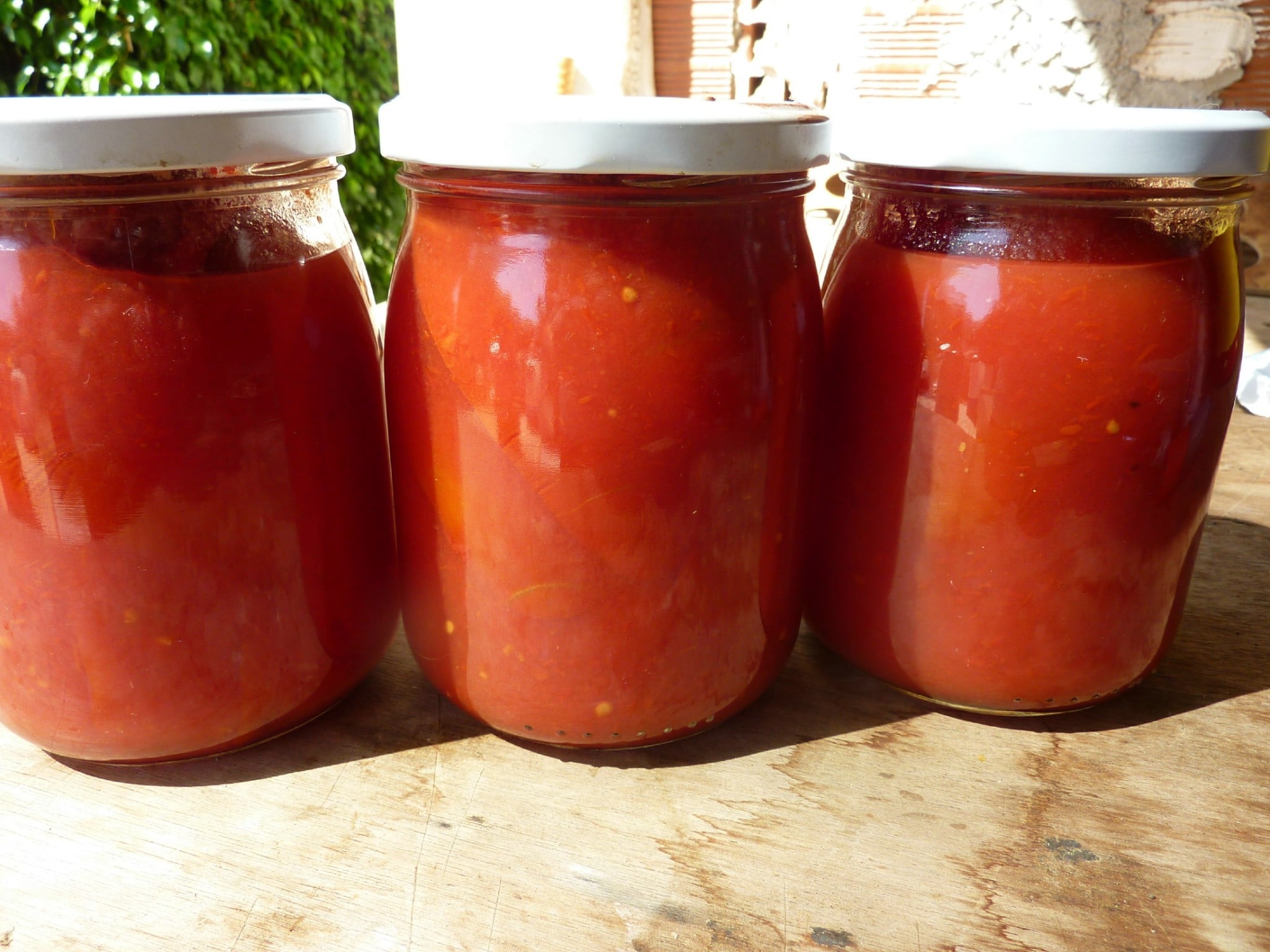
Jump to:
- Canning tomato sauce is a social event
- The truth about San Marzano tomatoes
- Cleaning the tomatoes
- Pre boiling the tomatoes
- Straining the water from the tomatoes
- Grinding the tomatoes
- Zero waste
- Filling the cans
- Preparing the barrel
- Placing the Jars in the Barrel
- Boiling the canned tomato sauce
- The Rewarding Lunch
- The Day After: Sharing the Fruits of Labor
- Sustainability and Zero-Waste: The Heart of the Tradition
- How to use the canned tomato sauce
- CANNED RECIPES YOU MIGHT ALSO LIKE
- 📋The Tradition of Canning Tomato Sauce in a Barrel
These age-old canning recipes transform these fresh tomatoes into a thicker sauce suitable for long-term storage.
During the winter, we transform this basic tomato sauce into pasta sauce (which we do not call marinara sauce), homemade pizza sauce, or as a base to many more recipes
As winter approaches, Italian pantries become a testament to this September tradition, stocked with jars of home-canned tomato sauce, each waiting to add flavor to a hearty meal.
This isn't just about preserving food – it's about encapsulating a piece of Italian heritage in every jar.
If you want to make it in your kitchen you can find the recipe: Italian Tomato Sauce Recipe With Fresh Tomatoes
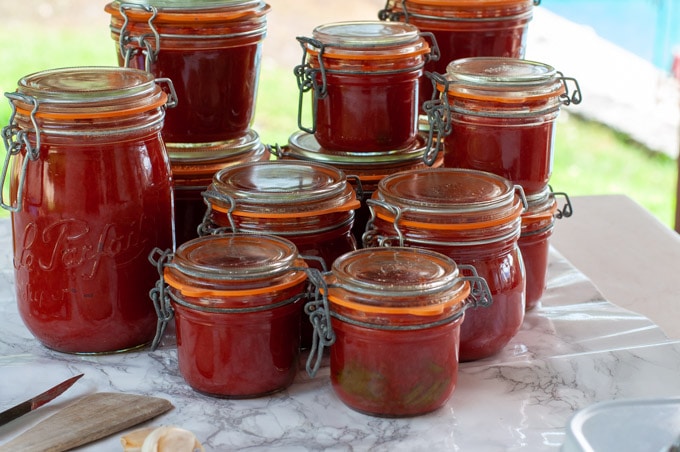
Canning tomato sauce is a social event
In the southern regions of Italy, the art of canning tomato sauce is steeped in tradition, passed down through generations.
Eager to delve into this rich history, I decided to reach out to someone deeply rooted in this practice: my cousin, Roberto Lombi, a respected agronomist.
Roberto is a person who exudes an infectious energy.
He's pragmatic, often diving into tasks with little fuss, and harbors a profound appreciation for nature in its most genuine form.
His passion for authentic food preservation has even taken him to Burkina Faso, where he volunteered multiple times, imparting his knowledge on cheese-making and preserving farm products to local farmers.

Now, as winter looms, Roberto is gearing up for the canning season.
Staying true to the age-old traditions, he adopts the most straightforward and cost-effective method for canning: using a barrel.
But in Italy, canning tomato sauce isn’t just a task; it’s a grand "EVENT", and Roberto isn't doing it alone.
He transforms this ritual into a jovial gathering, making tomato sauce alongside a vibrant team of friends and family.
Introducing the crew: Nino, a fellow agronomist; his spirited wife, Marinella; and his ever-enthusiastic brother-in-law, Enzo.
The stage is set.
Let the tomato canning festivities begin!
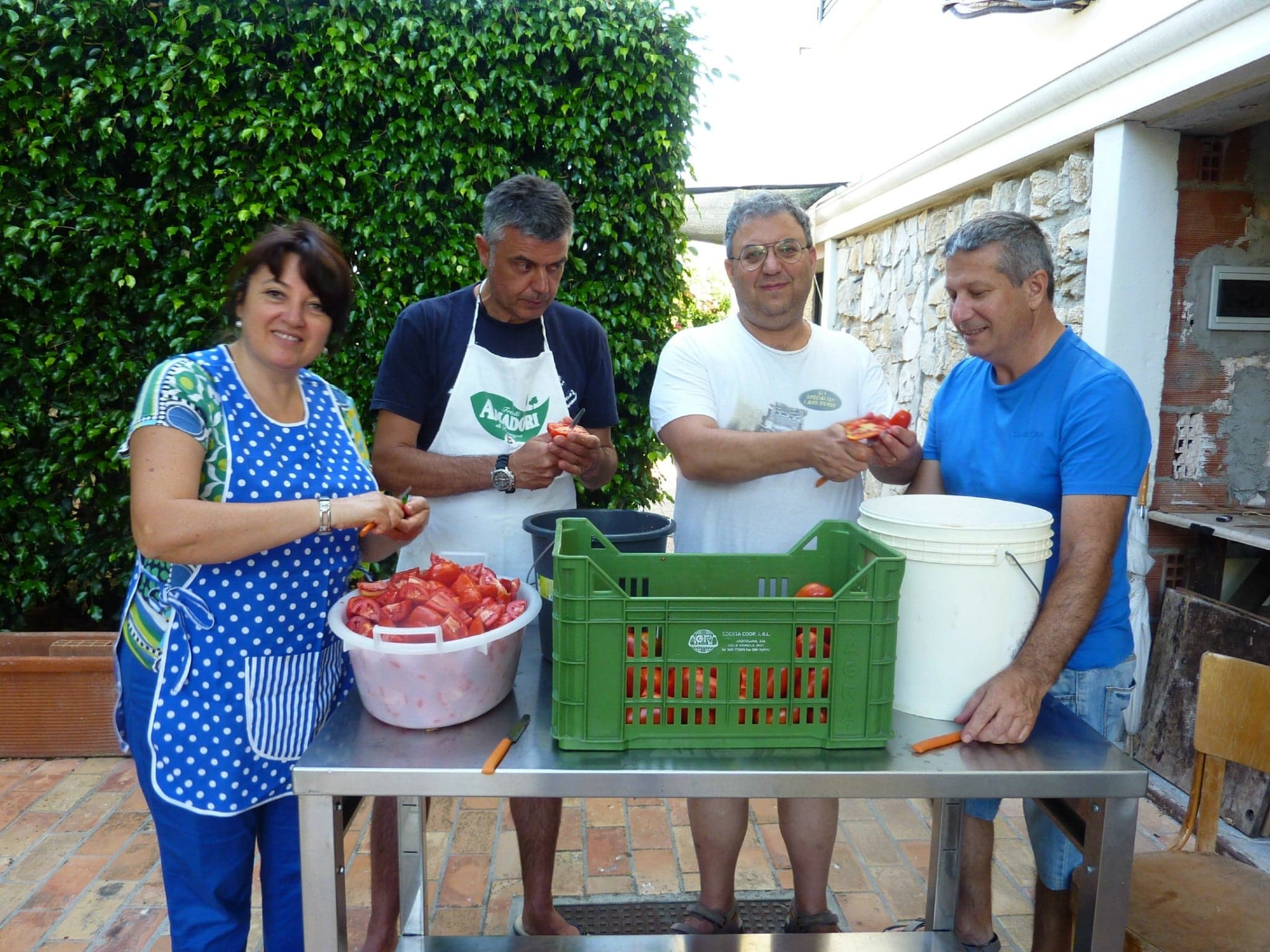
The truth about San Marzano tomatoes
The day before, Roberto went to an organic farm and bought 150 stones - 1 ton of organic long plum tomatoes.
The closest there is to San Marzano.
It is known that the San Marzano tomatoes are the best tomatoes for making sauce as they have a low water level content, but the truth is they no longer exist!
Unfortunately, as Roberto explained, the real San Marzano tomatoes were decimated by disease some years ago.
So what are sold as San Marzano are not the original, but are the closest variety to them.
You can find out more about it here: San Marzano Tomato Plants & Diseases
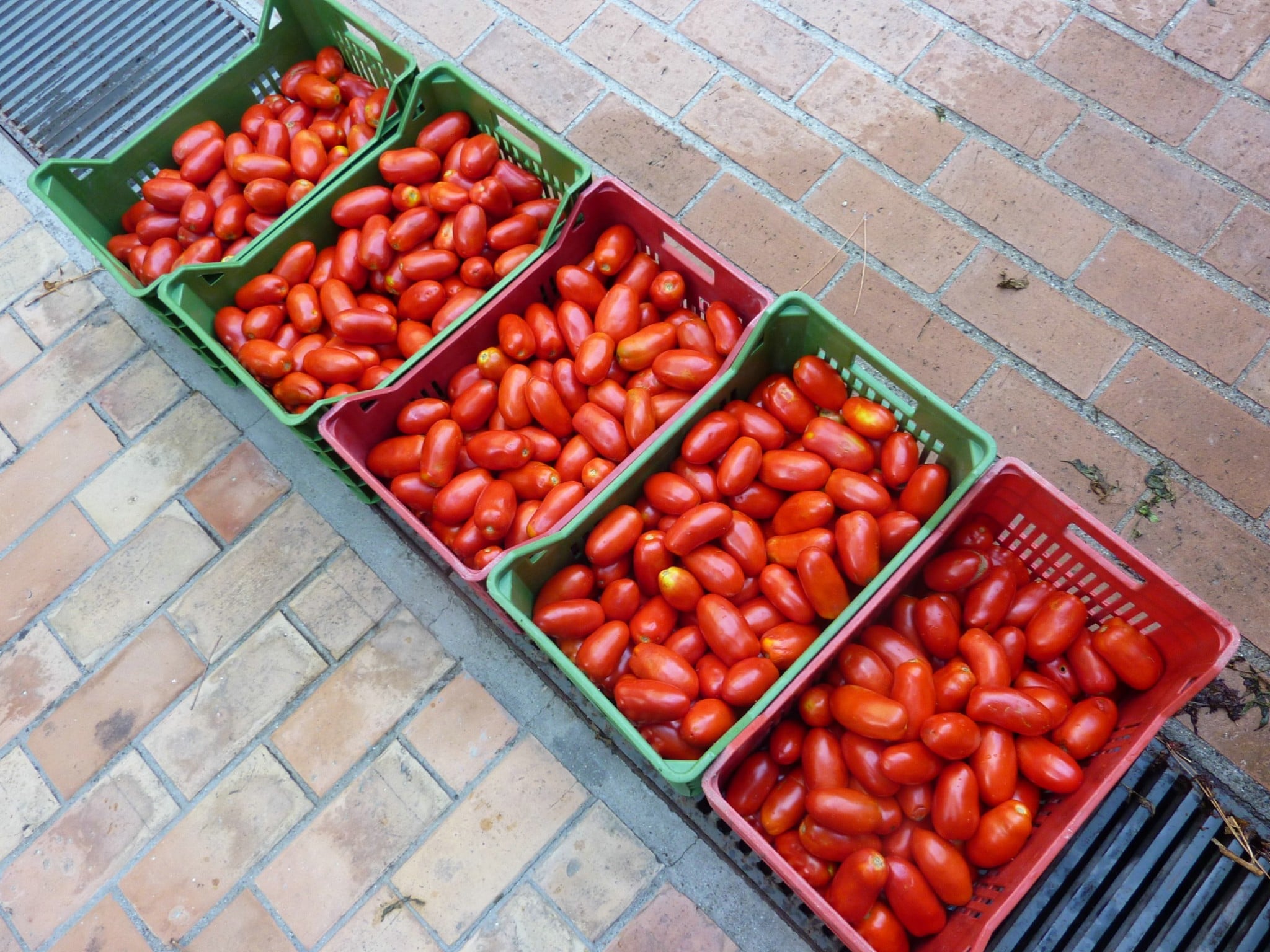
Cleaning the tomatoes
With a passion for preserving tradition, our day began as the first light broke.
We convened at Roberto's place promptly at 8 o'clock in the morning, determined to get an early start.
Lined up were five robust crates, each brimming with tomatoes, awaiting their transformation.
Without delay, we rinsed each tomato under a steady stream of running cold water, ensuring they were pristine for the process ahead.
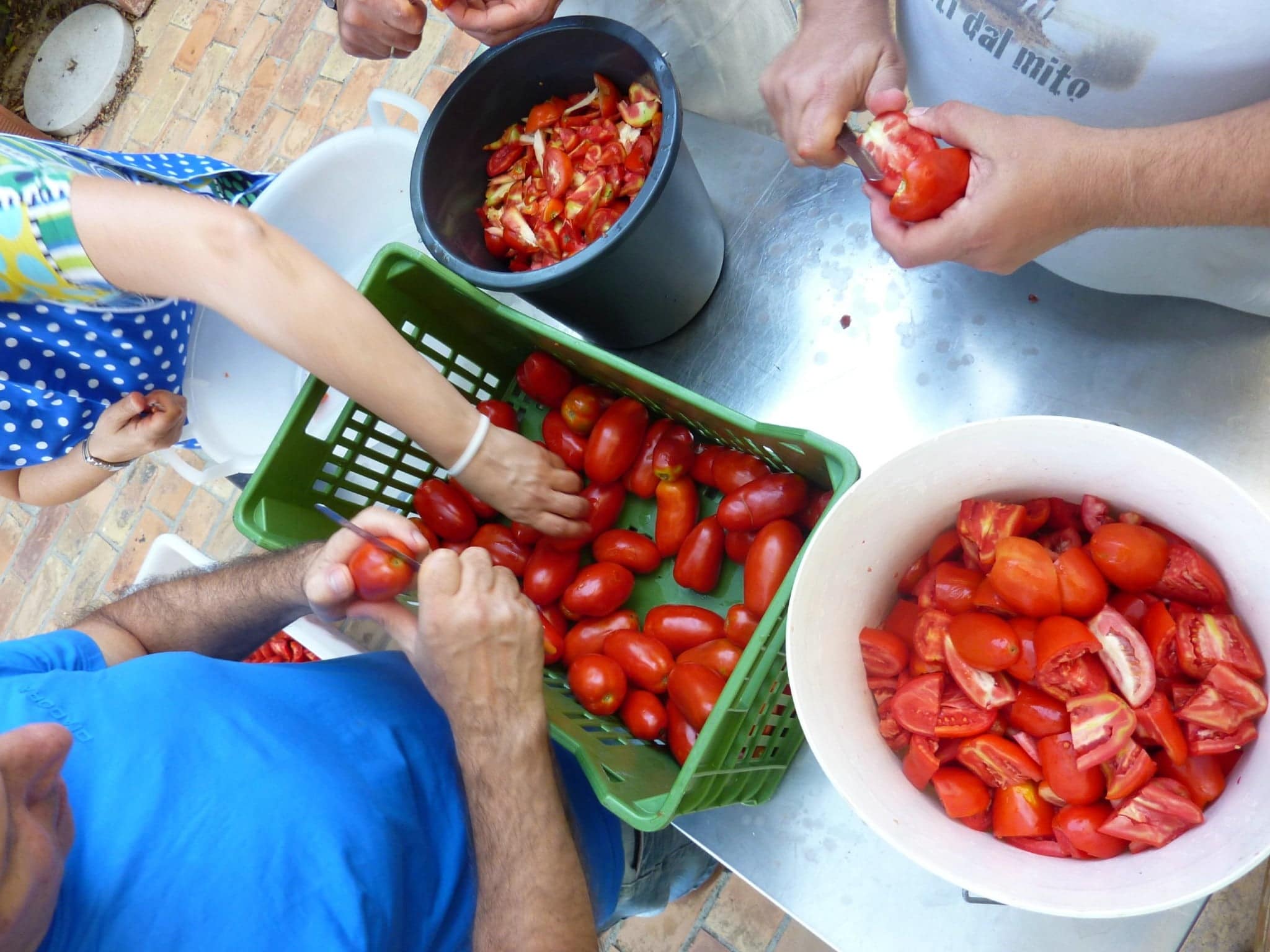
As the sun climbed higher, casting a warm glow over us, everyone rolled up their sleeves, diving into the task.
Each tomato was meticulously quartered with precision, and we carefully excised the green stem connection and discarded any blemished or damaged parts.
The atmosphere was thick with anticipation, and the rhythmic sound of slicing tomatoes punctuated our shared enthusiasm.
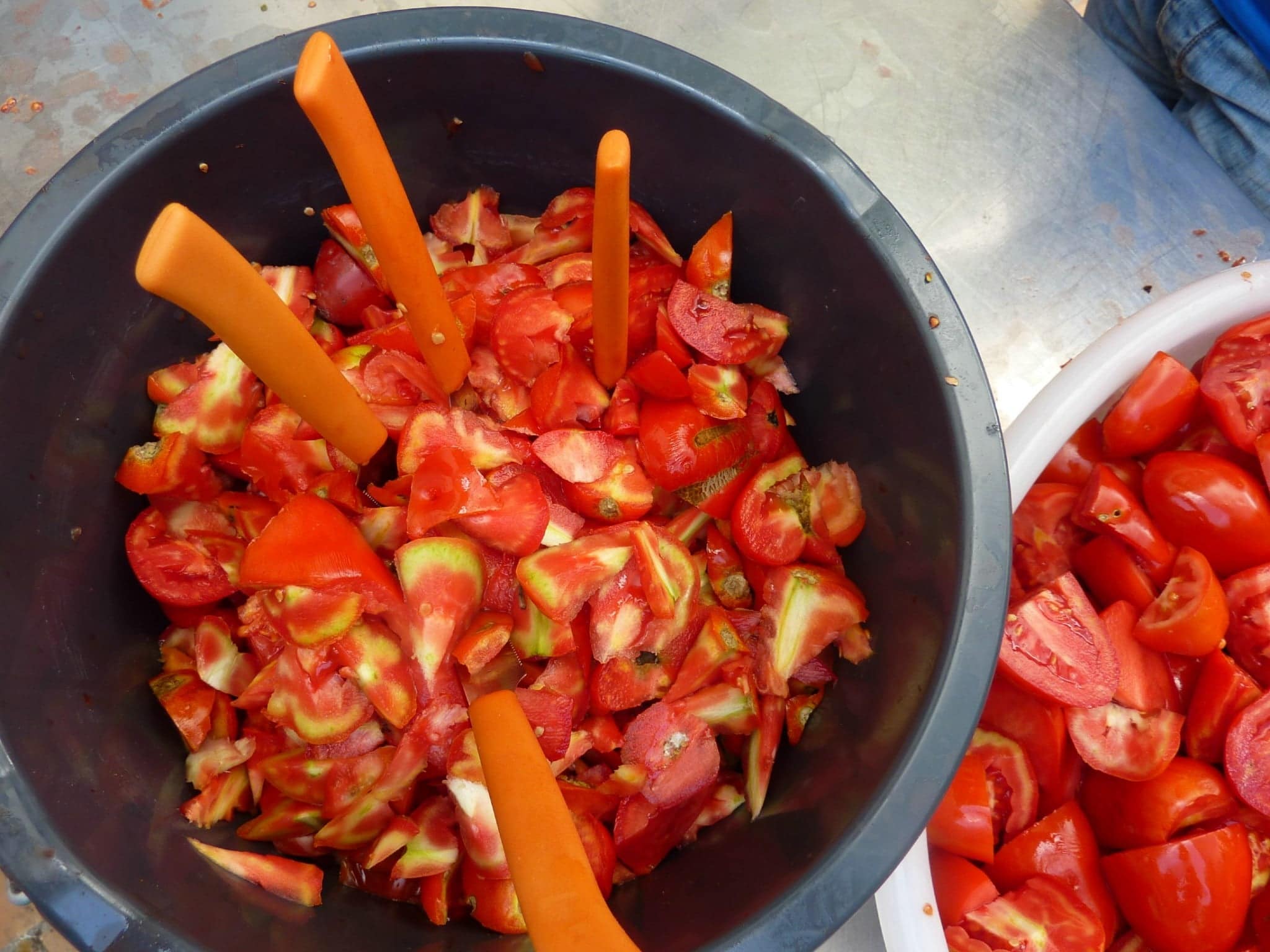
Pre boiling the tomatoes
Once a bucket was filled with the freshly prepared tomatoes, they were transferred to a large stockpot, or caldron, set over a steady flame.
The lid was secured atop, allowing the tomatoes to simmer in their own juices.
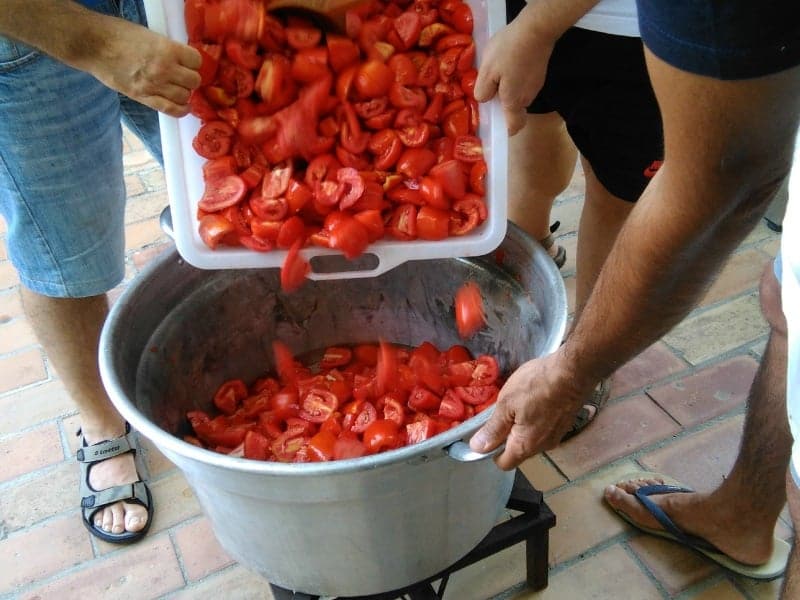
Contrary to what one might think, no additional water was poured in.
As they gently boiled, the tomatoes naturally released their inherent moisture.
Periodic stirring was essential, ensuring that the tomatoes didn’t adhere to the base of the pot, keeping the consistency smooth and uniform.
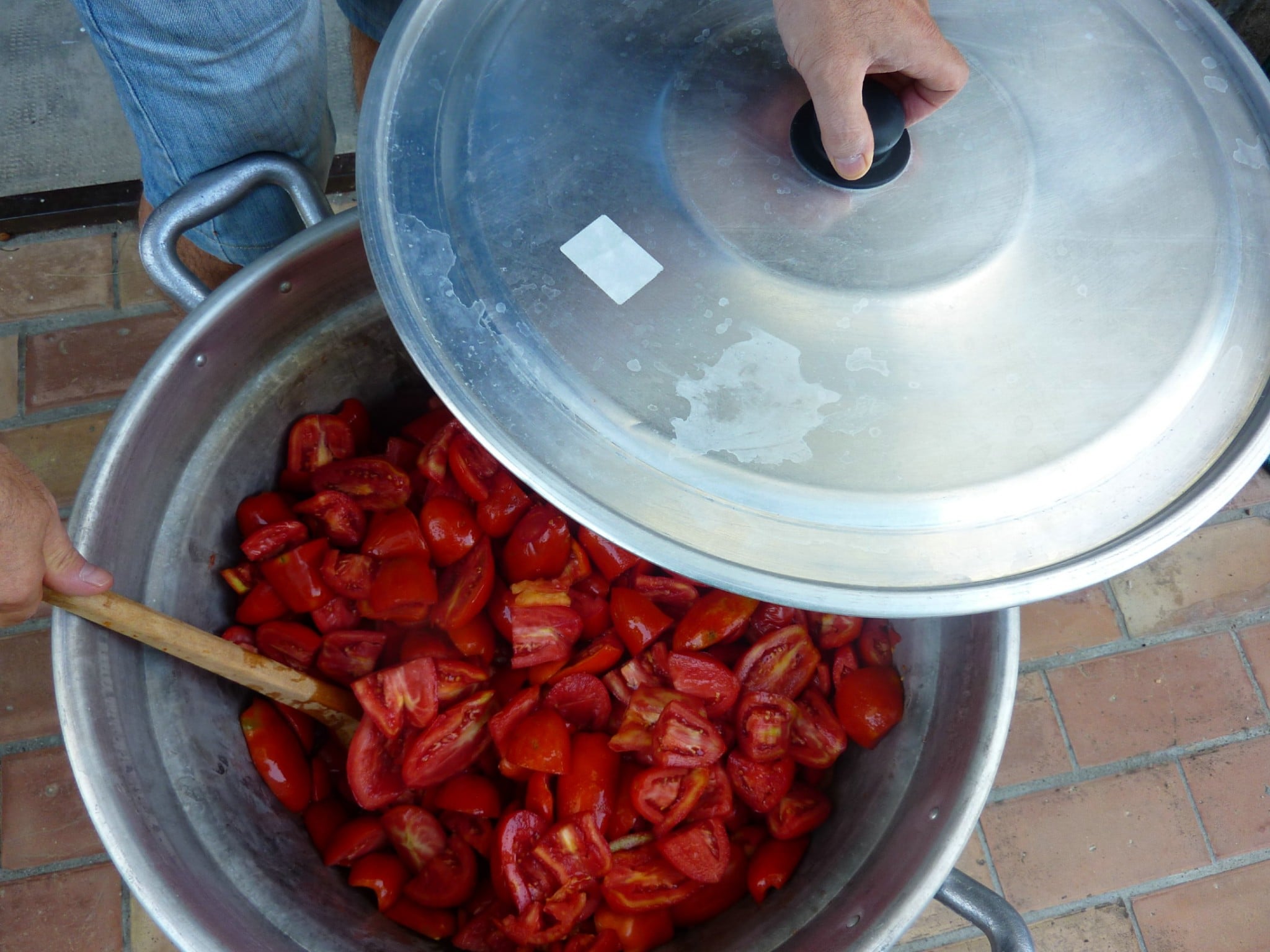
Straining the water from the tomatoes
After the tomatoes had simmered to the point where they softened and lost their firmness, they were carefully ladled back into their original crates with a slotted spoon.
These crates were preemptively lined with old but impeccably clean towels, ensuring a gentle landing for the softened produce.
Strategically positioning the crates over a drainage grid, we allowed the excess hot water from the tomatoes to gradually seep away, ensuring that only the rich tomato pulp remained.
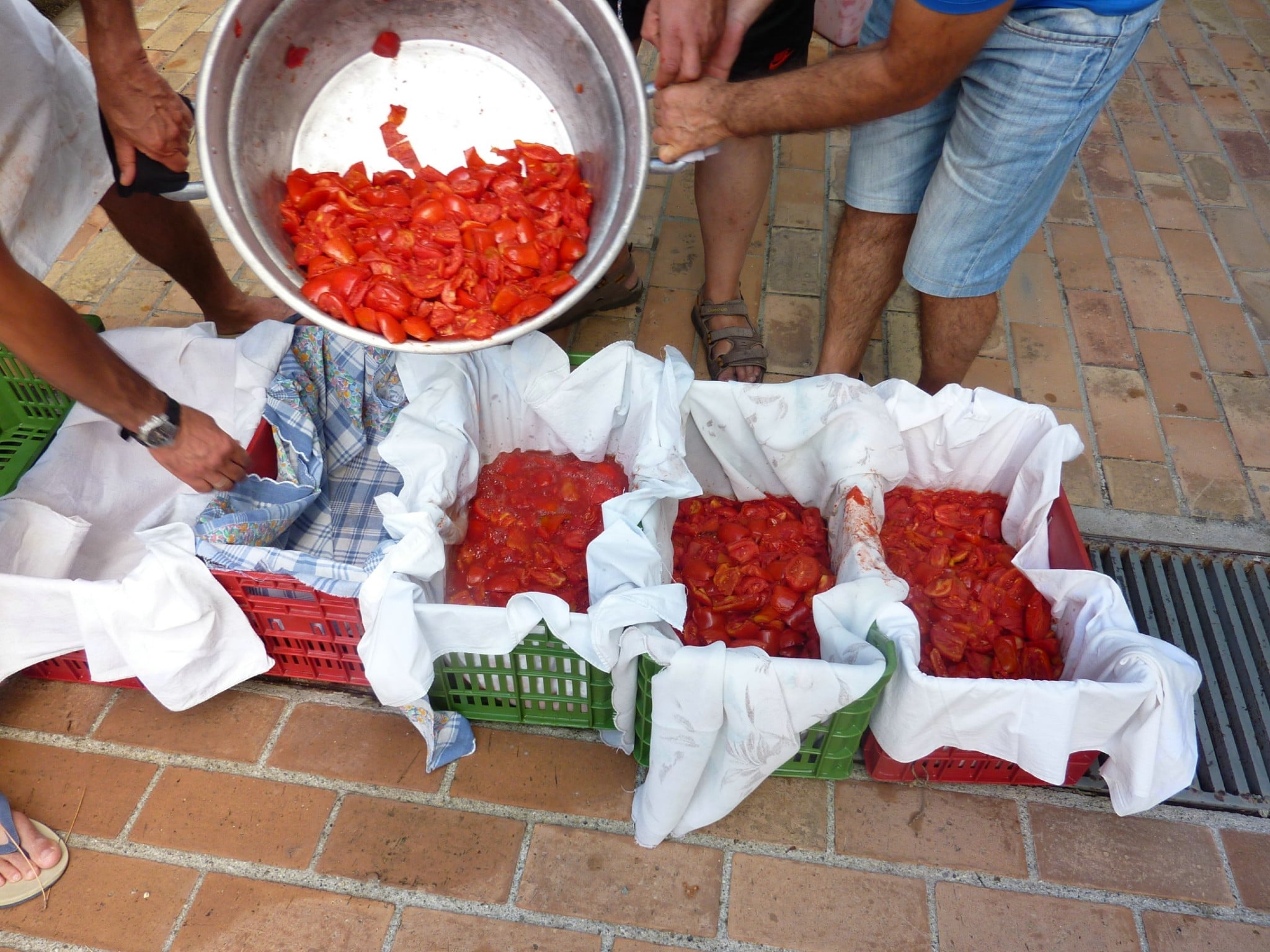
Just before moving on to the next step, one final squeeze was given, ensuring the best consistency for the sauce to come...
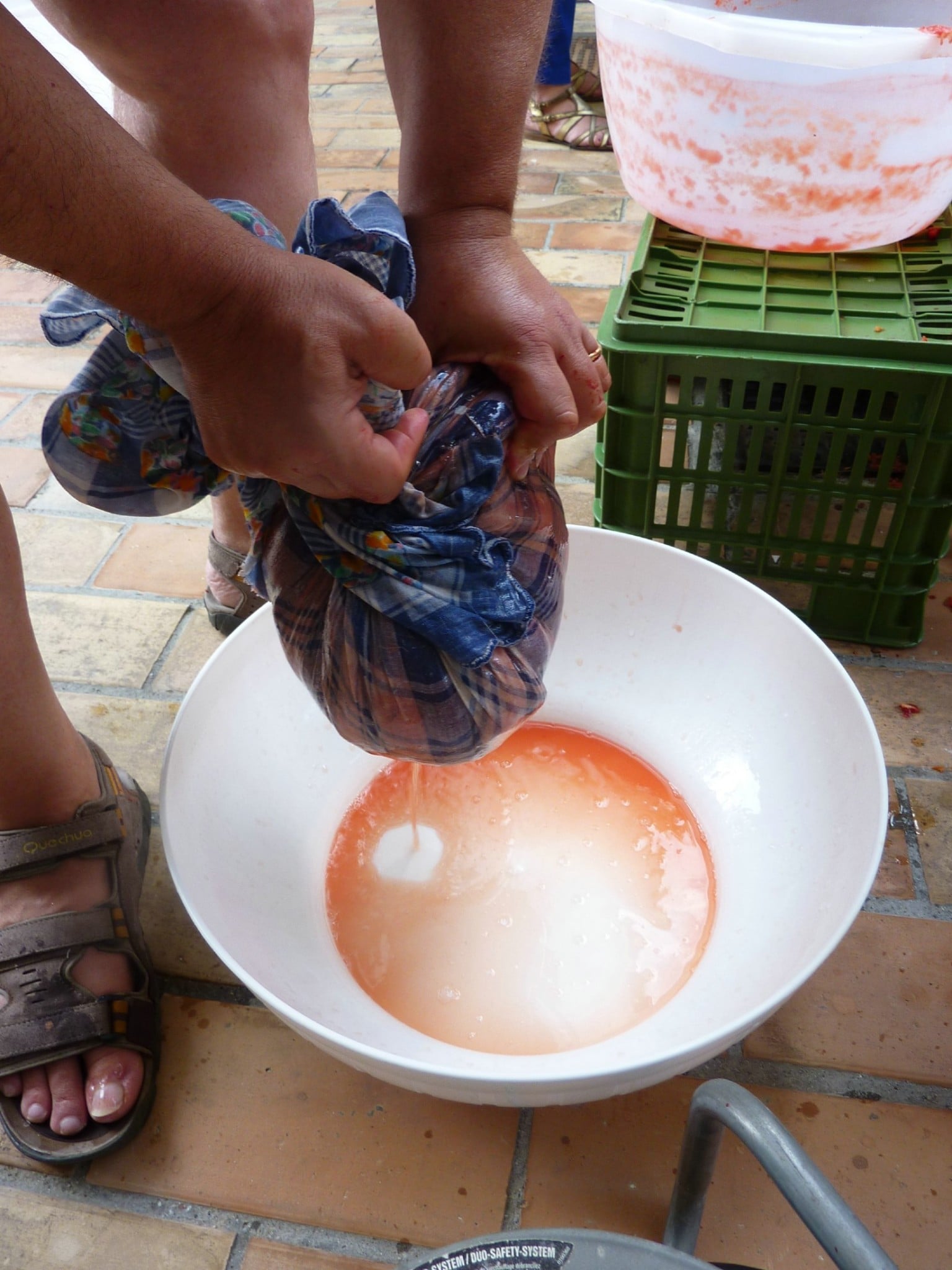
Grinding the tomatoes
The softened tomatoes were then introduced to the food mill machine, a quintessential tool in the canning process.
As the tomatoes were ground, the machine ingeniously separated the pulp from the tomato skin, ensuring a smooth and velvety sauce.
However, to guarantee that no valuable pulp clung to the skins, they were passed through the mill a couple of times.
Every ounce of tomato goodness was meticulously extracted.
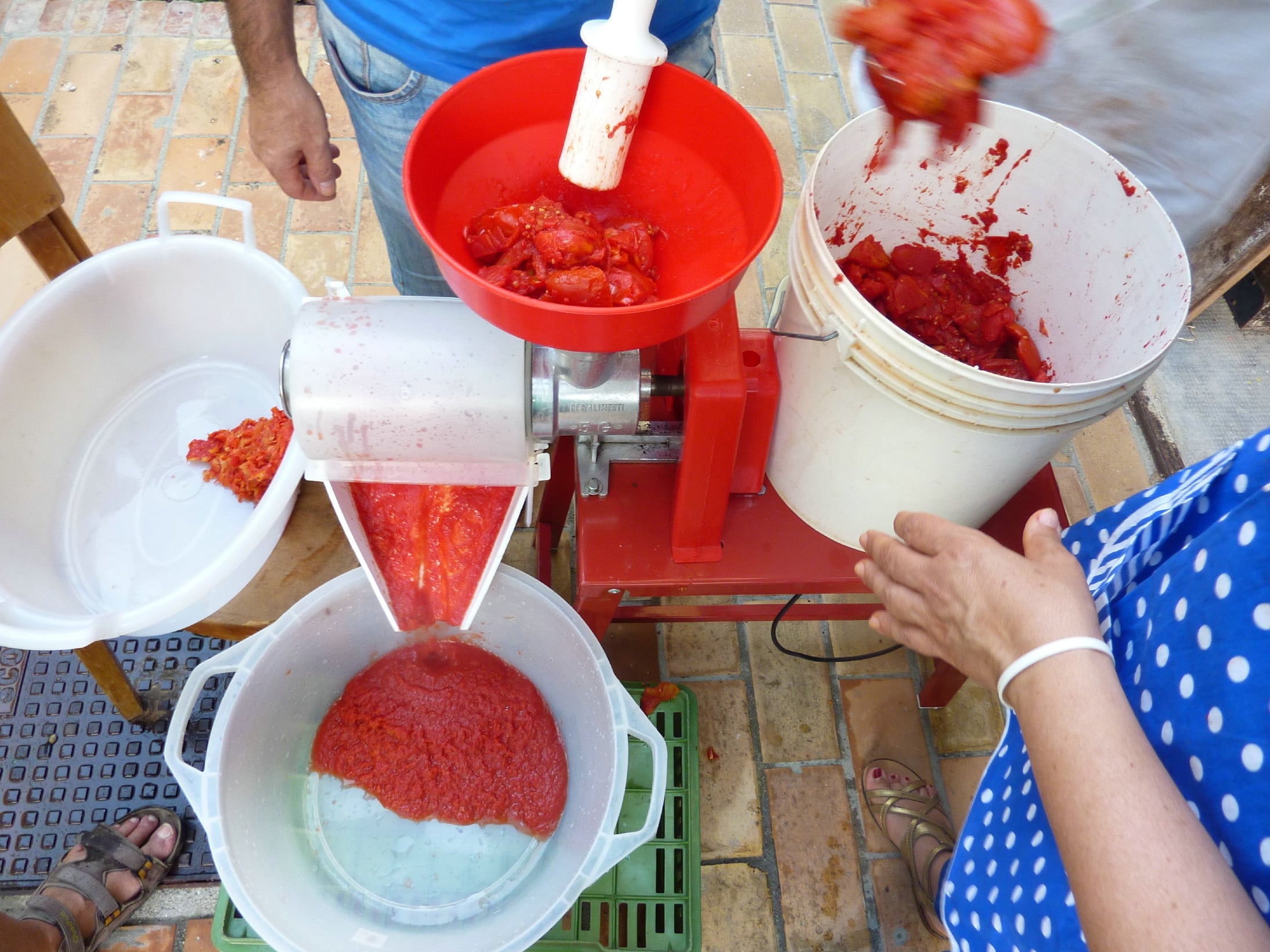
Zero waste
In the spirit of sustainability and the age-old Italian belief of utilizing every part of the produce, nothing went to waste.
The separated skins, rather than being discarded, were set aside for a greater purpose.
They would later be incorporated into compost, providing rich, organic nourishment for the next year's tomato plantation.
This cyclical process beautifully showcases nature's ability to replenish and sustain when treated with respect and care.
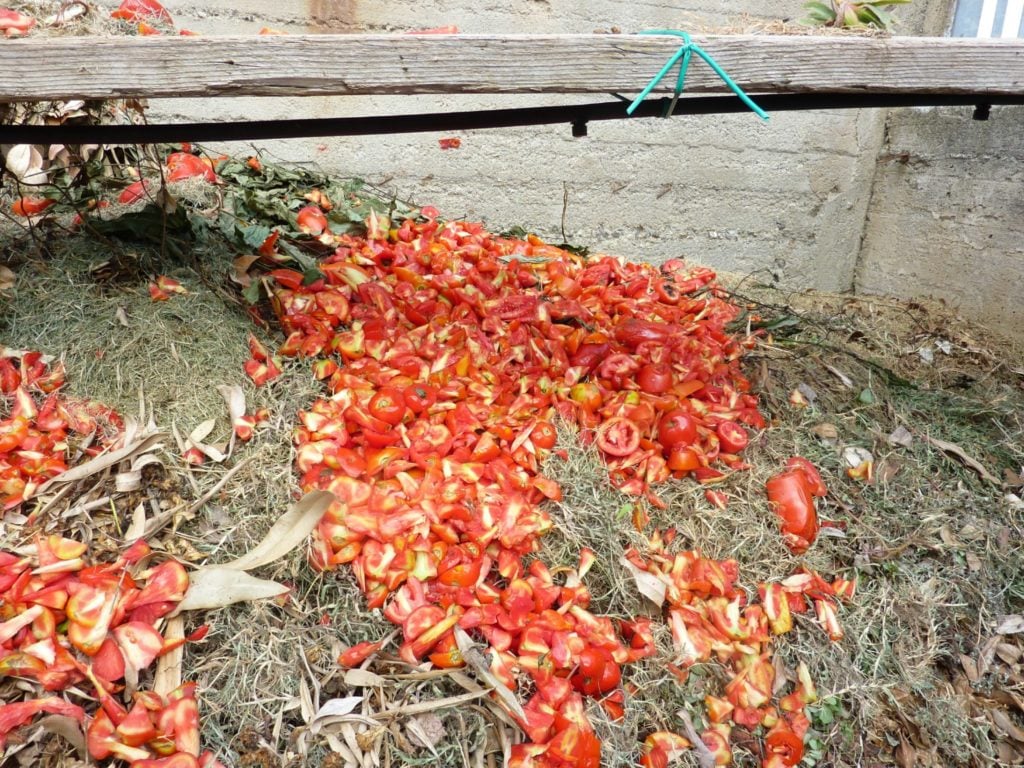
Filling the cans
The first step in canning the tomato sauce began meticulously with the glass jars everyone had already sterilized.
Both quart jars and pint jars were on standby, ensuring flexibility based on the quantity of sauce to be stored.
Using a canning funnel to avoid spillage and maintain cleanliness, the tomato sauce, which had a relatively thin consistency, was poured into the hot jars.
Care was taken to leave adequate space at the top, allowing for expansion during the processing time.
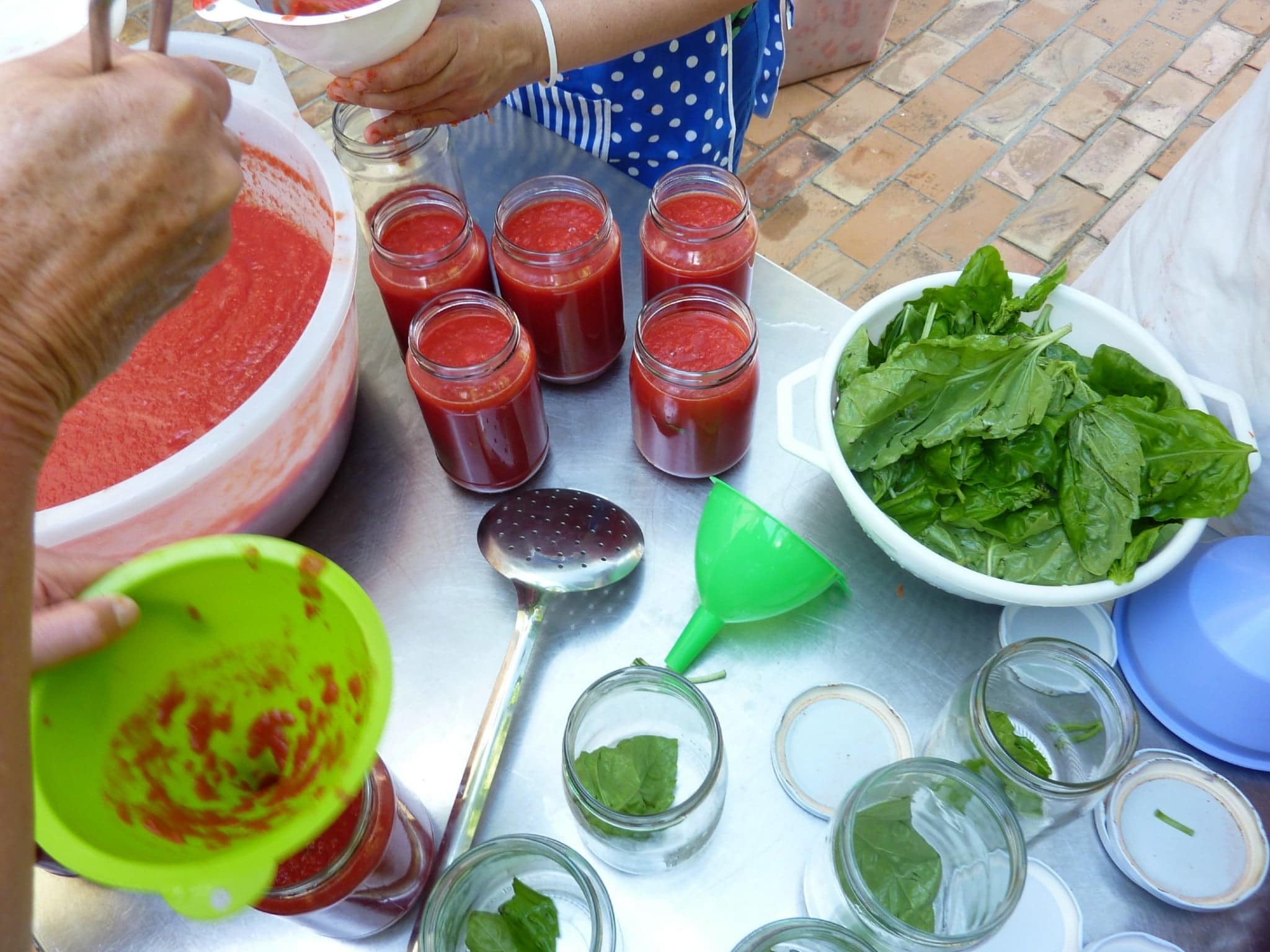
A single basil leaf was added to each jar, infusing the tomato-based sauces with an aromatic touch.
Once the jars were filled, the rims were wiped clean of any residual sauce, ensuring a perfect seal.
The lids were placed atop the jars, followed by the screw bands, tightened to fingertip tightness.
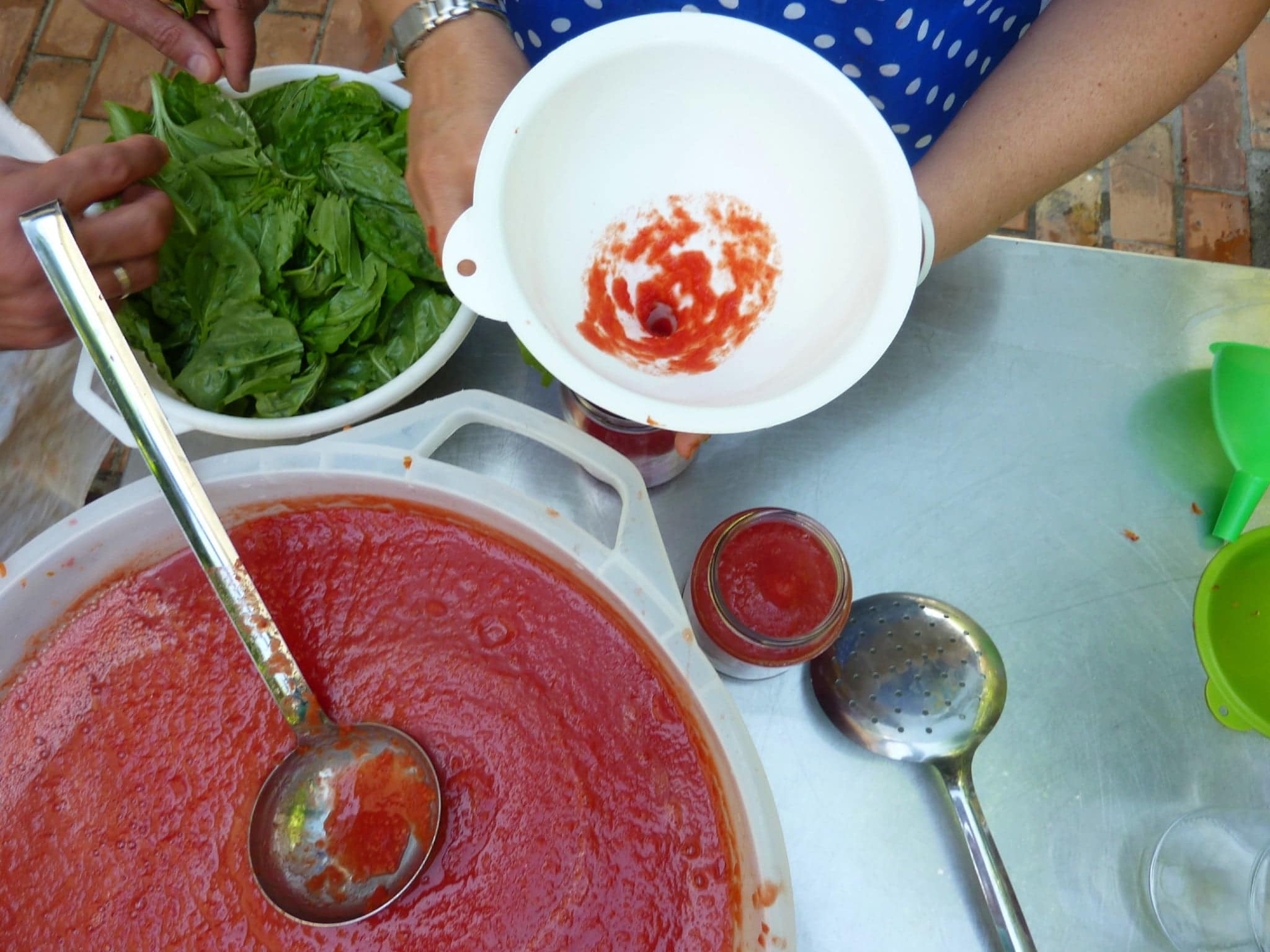
Preparing the barrel
With all the jars meticulously filled and sealed, attention shifted to the next crucial phase: preparing the barrel.
This traditional vessel was carefully positioned over the burners, taking the spot previously occupied by the caldron brimming with simmering tomatoes.
To cushion the base and ensure the jars were evenly heated without the risk of breakage, a potato bag was neatly spread at the bottom of the barrel.
This age-old technique not only protected the glass jars but also facilitated an even distribution of heat.
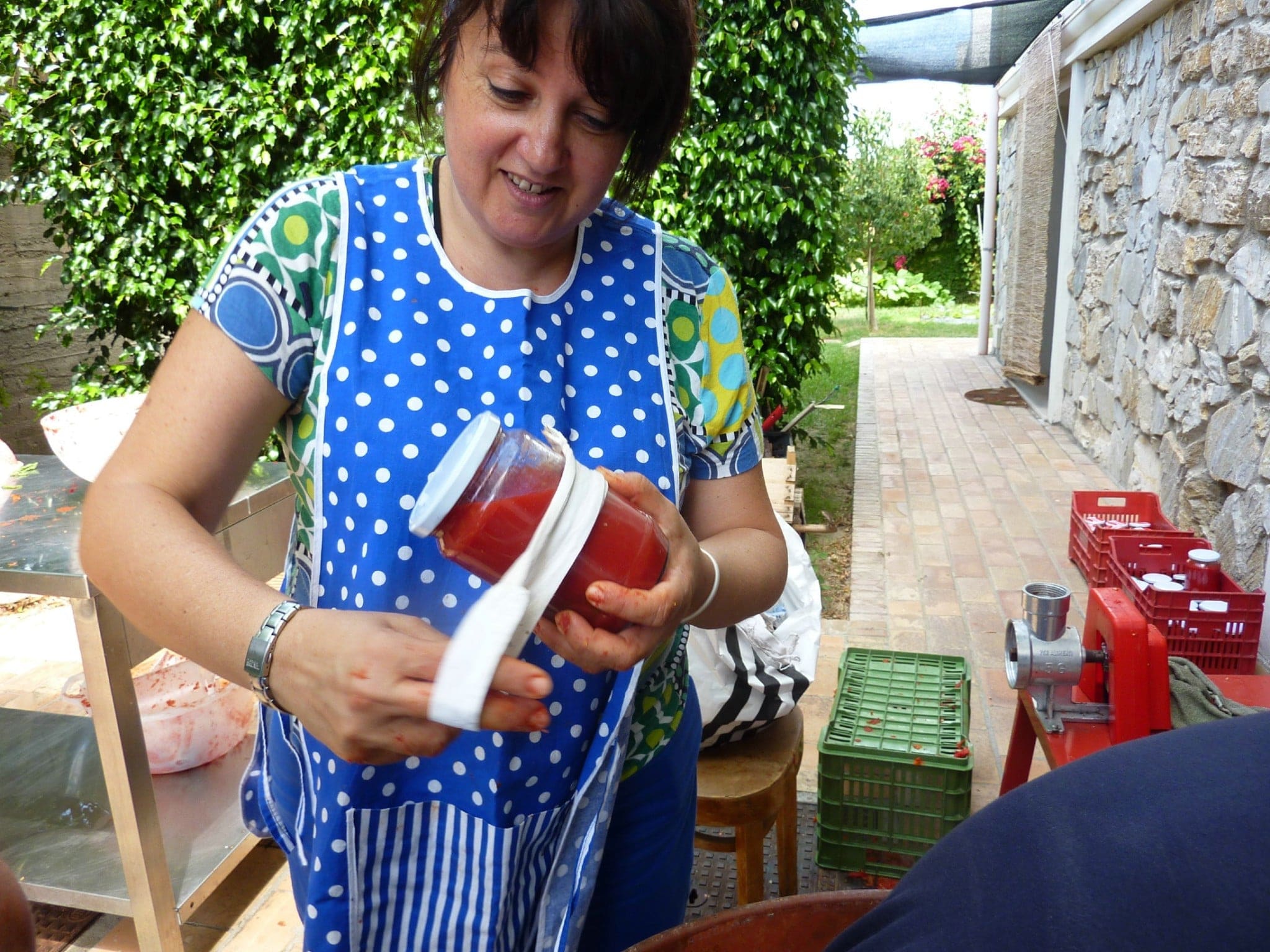
Placing the Jars in the Barrel
As the preparations advanced, each individual assumed their roles with precision.
Marinella, with dexterous hands, wrapped a band around each jar, ensuring they were adequately cushioned.
Nino and Enzo, in a well-coordinated dance, began the layering process inside the barrel.
After each layer of jars was placed, potato bags were spread over them.
This methodical layering, interspersed with the potato bags, ensured that the jars remained snug and insulated from direct contact with one another.
These fabric barriers played a crucial role.
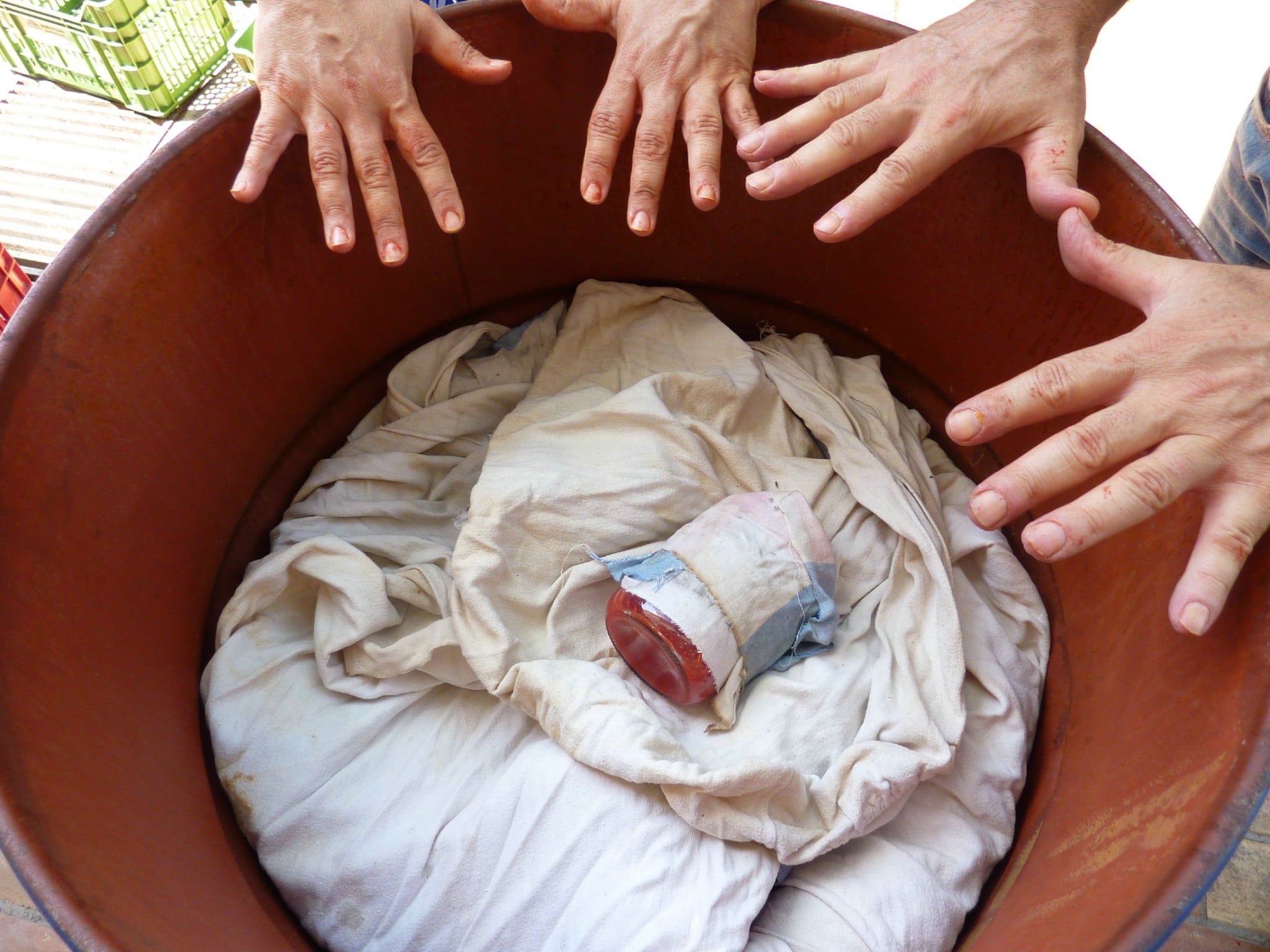
They effectively buffered the jars, preventing them from clinking together and potentially breaking during the boiling process.
With the barrel steadily filling up, water was poured in, immersing the jars completely.
Ensuring that everything remained in place, a cover was set on top.
To counteract the buoyancy of the jars and prevent them from floating and knocking against each other when boiling, a sturdy brick was strategically placed atop the cover.
With everything in position, the fire beneath the barrel was ignited.
All that remained was to wait for the water's gentle bubbles to evolve into a rolling boil, marking the commencement of the safe canning phase.
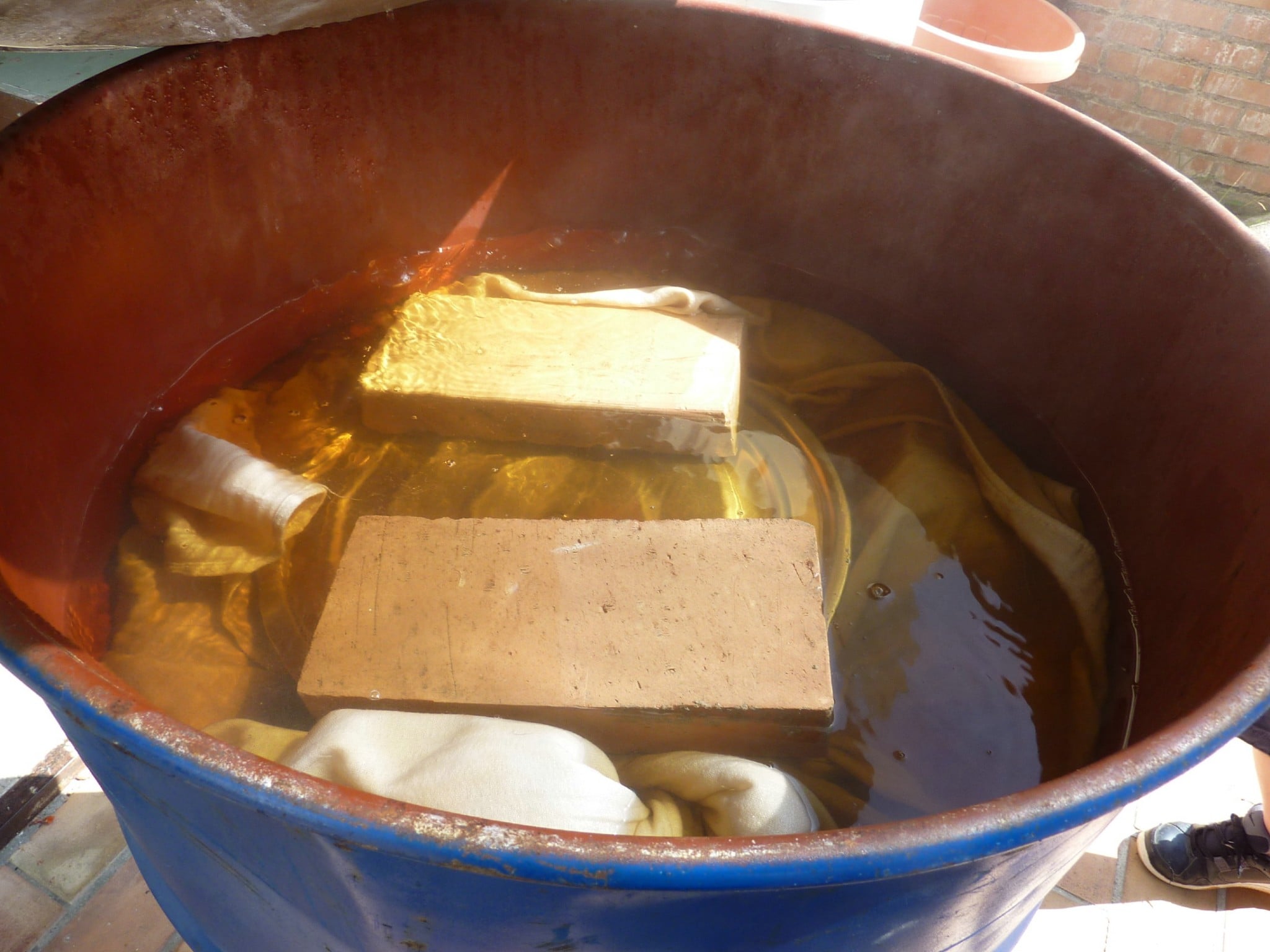
Boiling the canned tomato sauce
As the water in the barrel began to boil vigorously, it signaled the start of a critical hour-long phase.
The jars, snugly nestled within, were left to boil for a full 60 minutes.
This prolonged boiling was instrumental in ensuring that the sauces within the jars were effectively preserved.
While the jars underwent this vital process, our hands weren’t idle.
There was the aftermath of the day's labor to attend to.
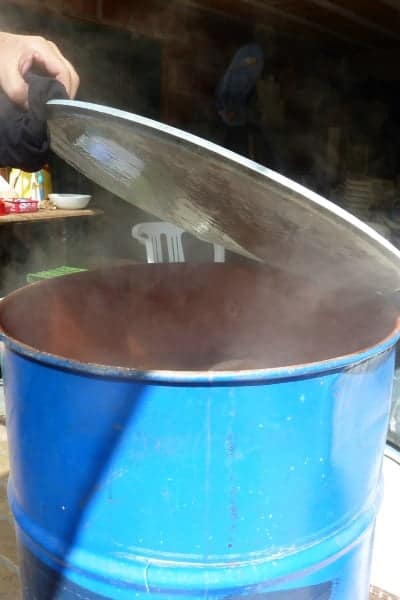
Every utensil, cutting board, pot, and pan was washed, scrubbed, and set aside.
The floor, which had witnessed the day’s activities, was swept and mopped, restoring it to its original state.
After the stipulated boiling time had elapsed, the jars within the barrel had undergone their final preservation phase and were now ready.
However, the intense heat trapped inside meant that the barrel and its contents needed to be untouched for a long time, allowing them a full day to cool down completely at room temperature.
Even a jar lifter wouldn't work in such a deep barrel.
For the time being, our part in this age-old ritual was complete.
With the heavy lifting done, it was a moment to pause, reflect, and take pride in the day’s accomplishments.
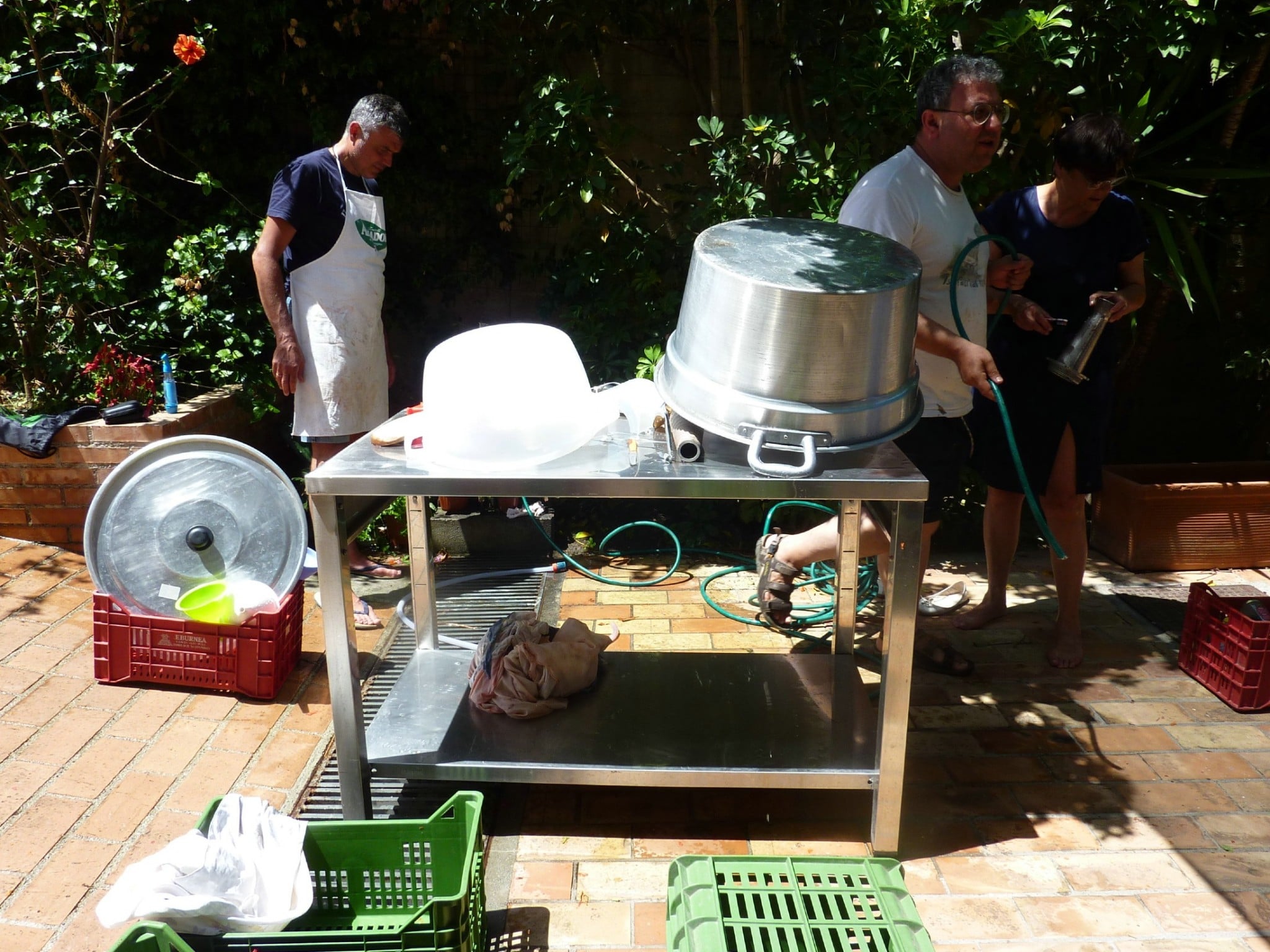
The Rewarding Lunch
Amidst the bustling activities of the day, we hadn't forgotten about life's essential pleasures.
A couple of jars filled with the freshest tomato sauce had been deliberately set aside.
Their destiny? To be transformed into a hearty plate of homemade spaghetti sauce, radiating with the flavors of just-prepared tomato sauce.
And as if nature itself was rewarding our hard work, our tasks concluded serendipitously around noon.
The sun stood high, casting a warm glow around, and the air was filled with the irresistible aroma of the simmering spaghetti sauce.
It was as if the universe conspired to ensure our hard work would be immediately rewarded.
Gathering around the table, laden with plates of spaghetti gleaming with fresh tomato sauce, it was a moment of pure joy.
Every bite was a testament to the morning's labor, a delightful fusion of tradition and the freshest ingredients.
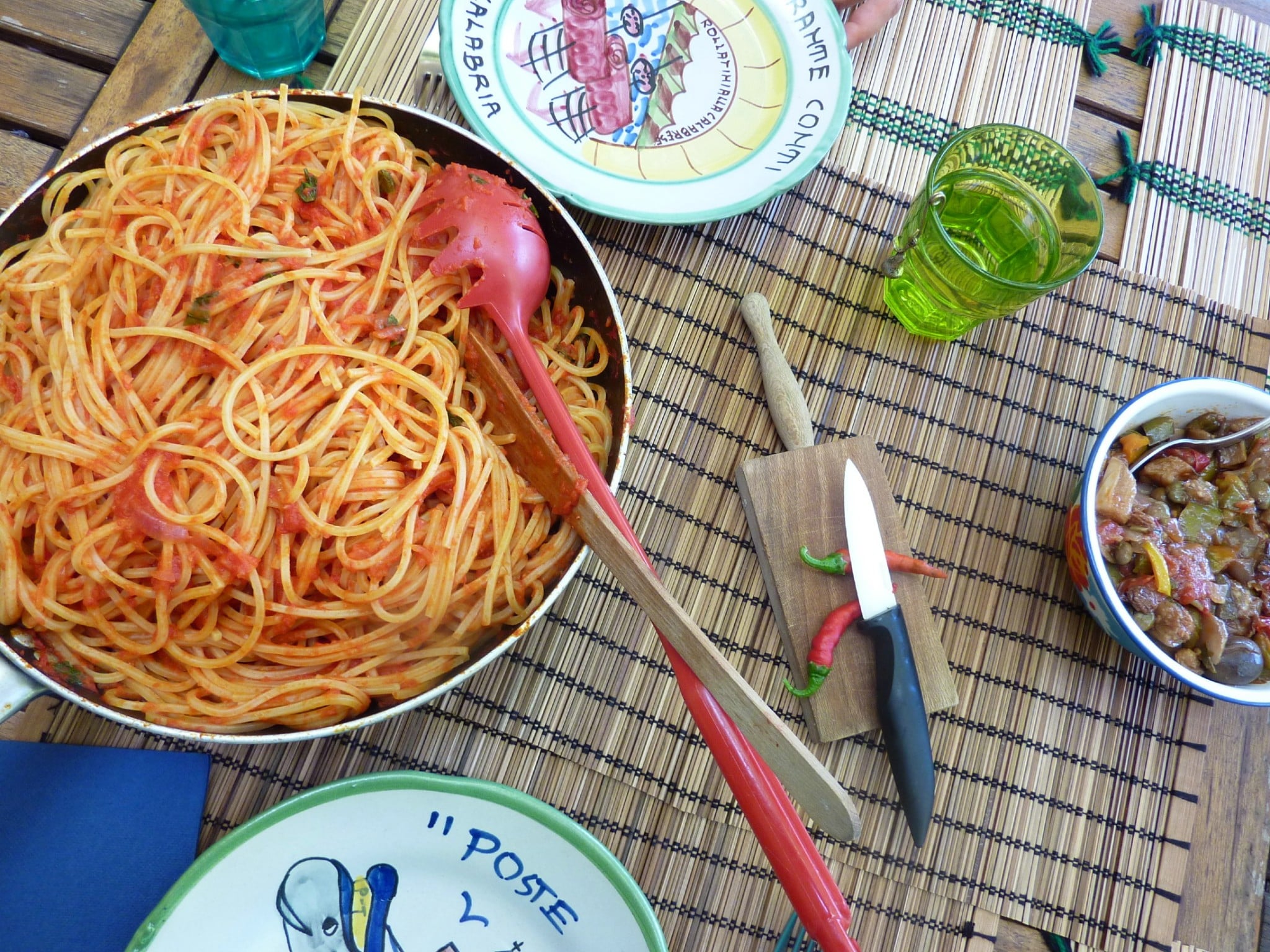
The Day After: Sharing the Fruits of Labor
The following morning dawned bright and clear, setting the tone for the culmination of our endeavor.
Having released its heat overnight, the barrel was now cool to the touch.
The water, which had bubbled and boiled with fervor the day before, was now placid.
One by one, the jars were carefully retrieved from the barrel.
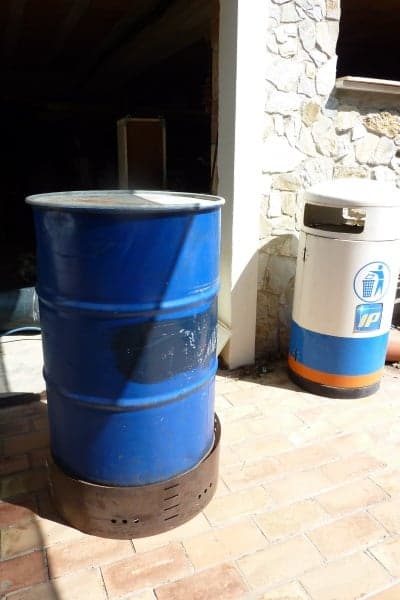
Their contents, the rich tomato sauce, gleamed with a deep red hue, embodying the essence of Italy's sun-ripened tomatoes.
The labor of love from the day before was evident in each jar.
As tradition dictates, these jars were distributed amongst all participants, a gesture that shared the delicious product and celebrated the communal effort into its creation.
This, in essence, encapsulates the tradition of homemade canned tomato sauce in Italy—a practice not just of preservation but of community, love, and sharing.
Fret not for those intrigued by this timeless ritual and looking to bring a slice of Italy into their kitchens!
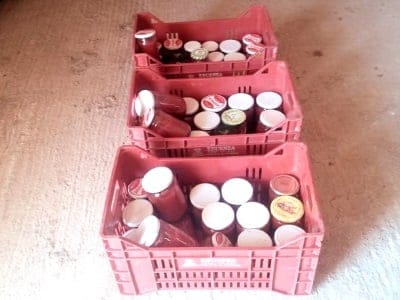
The recipe to create your canned tomato sauce is just a click away.
Dive in and experience the magic for yourself!
If you want to make canned tomato sauce in your kitchen, you can find the recipe:
Italian Tomato Sauce Recipe With Fresh Tomatoes
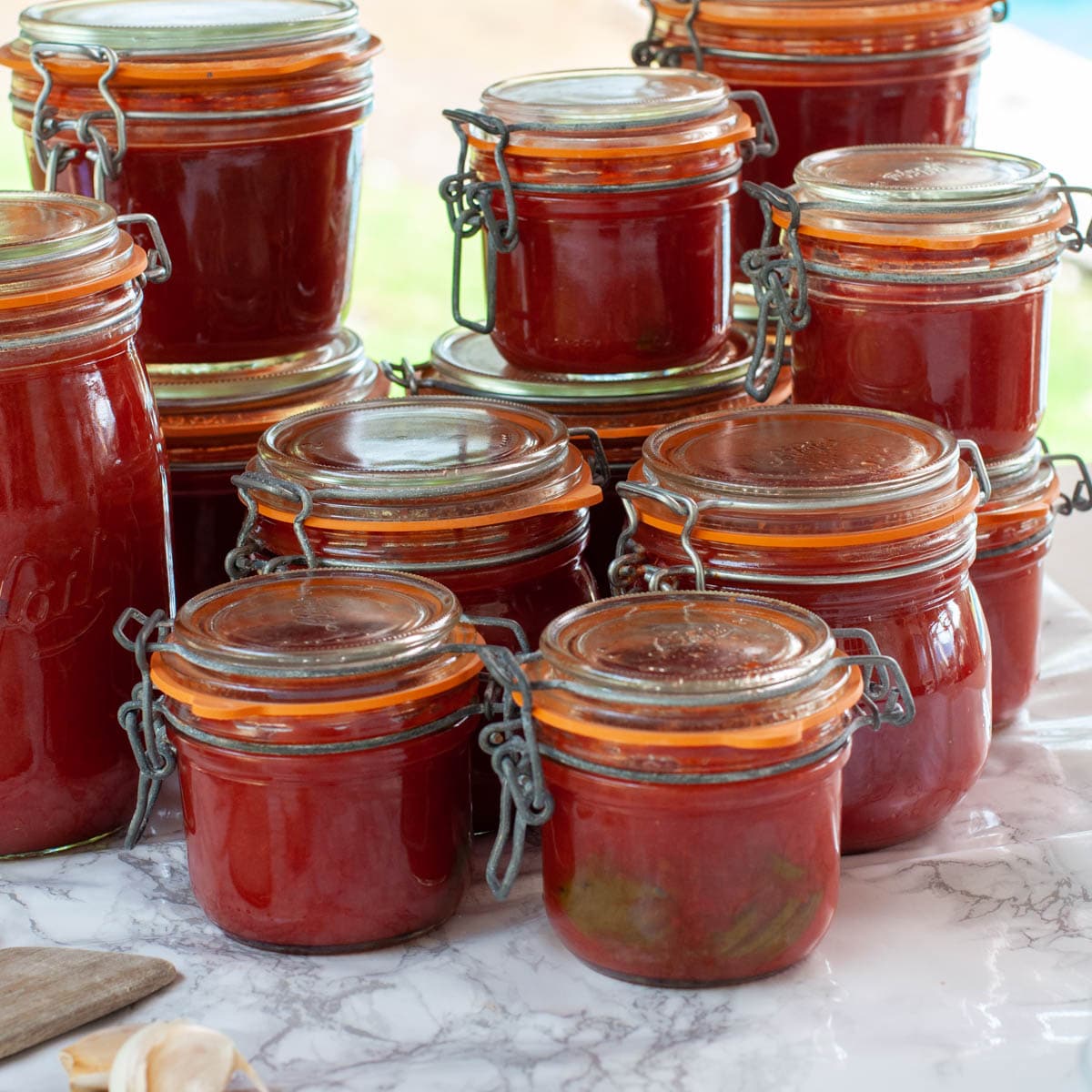
Sustainability and Zero-Waste: The Heart of the Tradition
Integral to this age-old Italian tradition of canning tomato sauce is a deep-seated respect for nature and sustainability.
Every step of the process was imbued with a consciousness towards minimizing waste and maximizing utility.
Recycled materials took center stage, underpinning the ethos of sustainability that runs deep in Italian countryside practices.
The barrels, burners, and even the potato bags used to cushion the jars had seen previous uses, thereby breathing new life into objects that might have otherwise been discarded.
Even the jars themselves were often repurposed, having previously housed other preserves or delicacies.
Moreover, the ethos of zero-waste was evident in the meticulous efforts to use every part of the tomato.
After the pulp was extracted for the sauce, the skins, often overlooked and discarded in modern practices, were valued and composted.
These would later enrich the soil, fostering the growth of the next season's tomato crop.
By intertwining sustainability with tradition, this method of preparing homemade canned tomato sauce not only preserves the flavors of the season but also upholds the principles of respect for the environment and resourcefulness.
It's a beautiful melding of flavors and eco-consciousness, ensuring that every bite taken is a testament to nature's bounty and mankind's responsibility towards it.
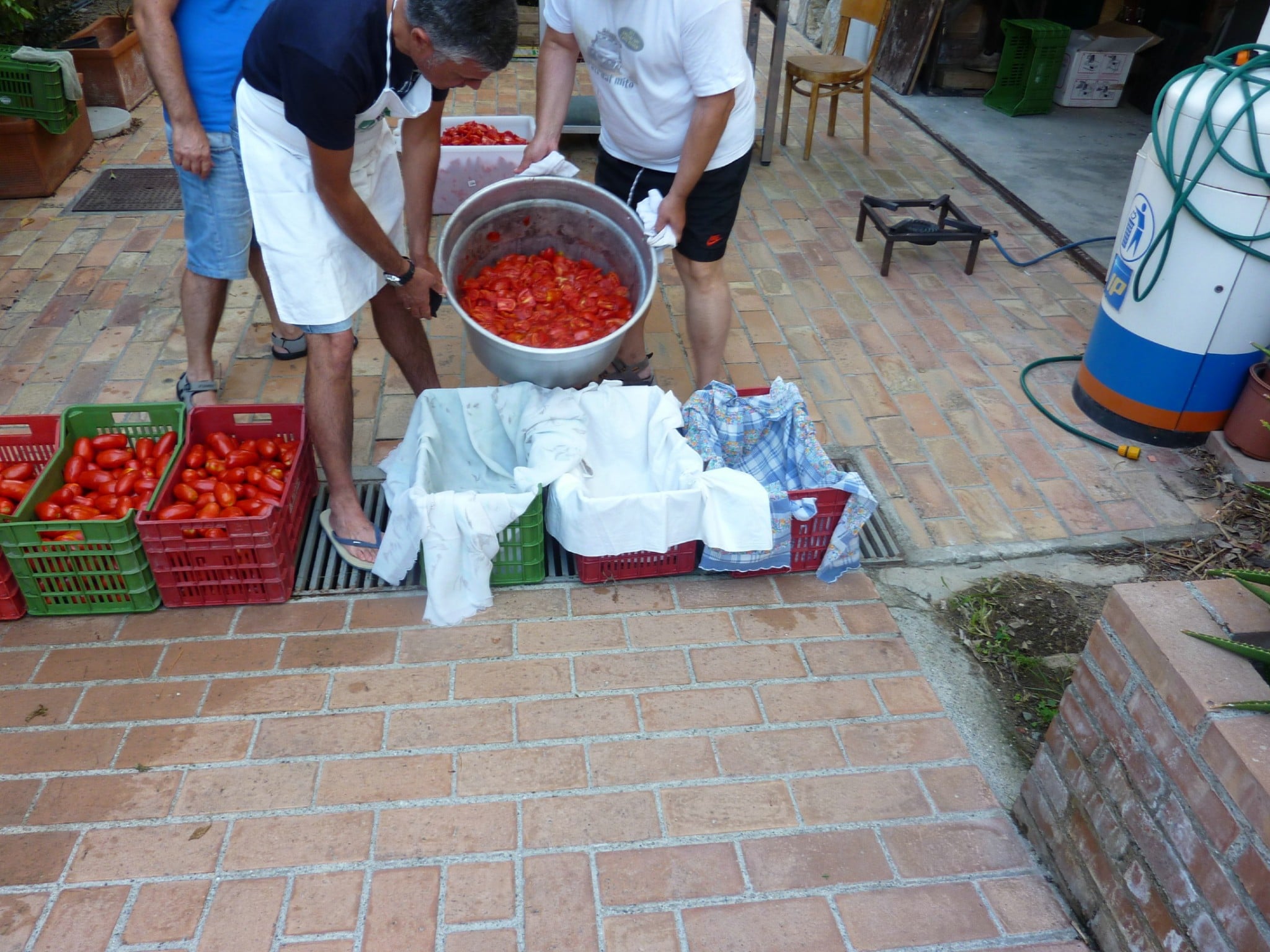
How to use the canned tomato sauce
With no addition of fresh herbs, salt, or olive oil, this simple sauce remains a pure, unadulterated base.
This allows it to seamlessly integrate into many dishes without overpowering or conflicting with other ingredients.
When a recipe requires a tomato base, this perfect sauce can be tailored to fit the exact requirements of that dish, ensuring optimal flavor harmony.
Here are some delectable recipes where this basic tomato sauce can be the star:
- Bolognese Sauce: By adding ground meat, onions, celery, and carrots, and simmering it all together, this tomato sauce is easily transformed into the beloved Bolognese sauce.
- Norma Sauce: A classic Sicilian pasta sauce, combining fried aubergines, ricotta salata, and sometimes a sprinkle of chili flakes, integrates beautifully with our basic sauce.
- Simple Tomato Sauce: Sometimes, all you need is a touch of garlic, a drizzle of olive oil, and a handful of fresh basil to turn this base into a delightful simple tomato sauce for pasta, pizza, gnocchi or lasagna.
- Ratatouille or Giambotta: This sauce is the foundation for these classic vegetable stews.
Keeping the sauce simple provides a blank canvas, ready to be painted with the flavors of any dish.
This is the genius of traditional Italian culinary wisdom, ensuring that one basic product can be the backbone of countless memorable meals.
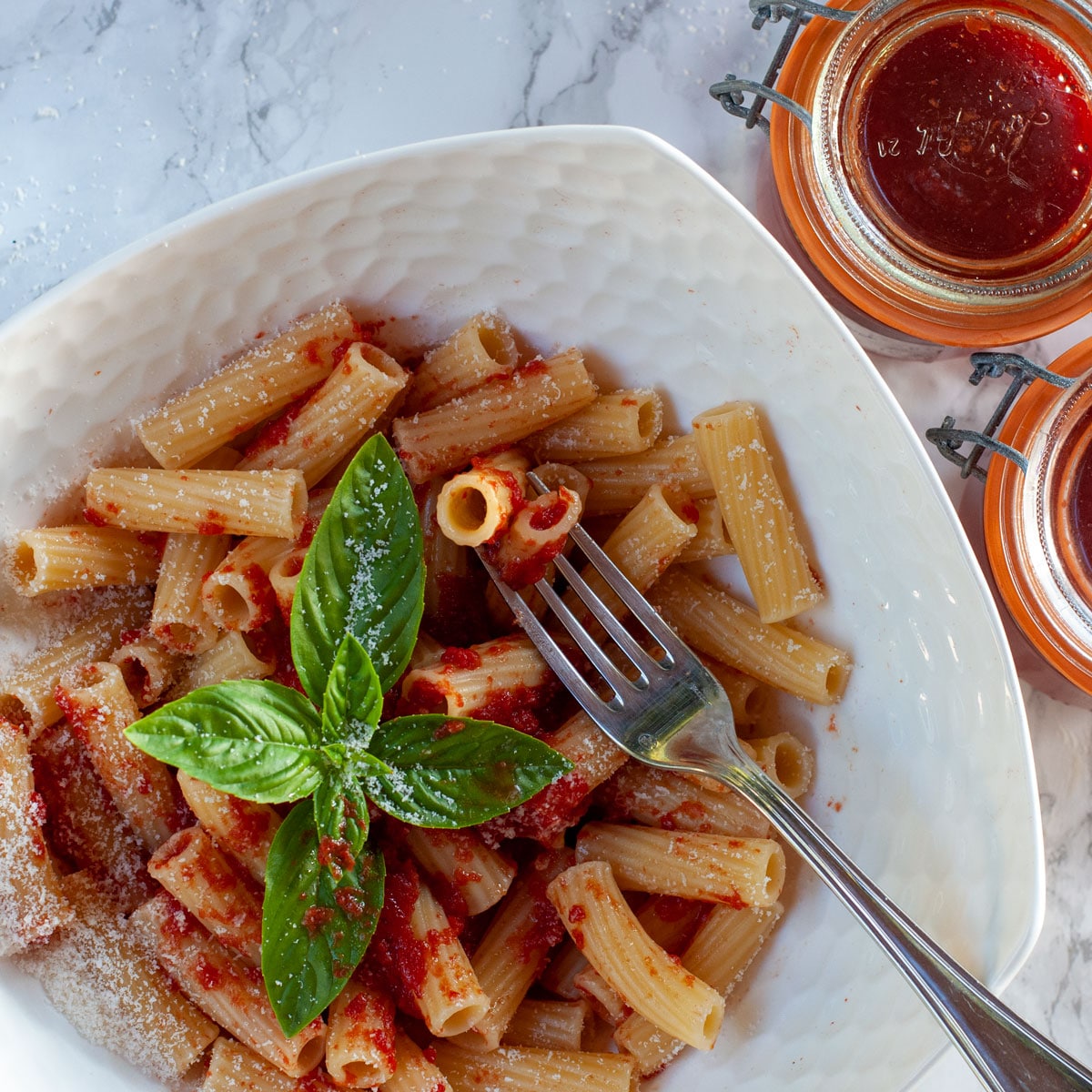
CANNED RECIPES YOU MIGHT ALSO LIKE
For more canned recipes, check out the category: Canned & Jams
Also check the recipes below:
If you are also making the Canned Tomato Sauce in a Barrel, leave your comment below I would like to hear from you. You can find more delicious ideas if you FOLLOW ME on Facebook, YouTube, or sign up to my newsletter.
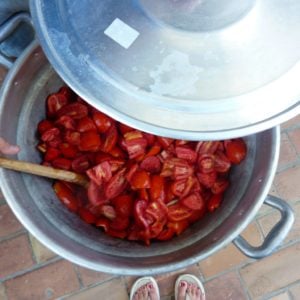
📋The Tradition of Canning Tomato Sauce in a Barrel
With such a large quantity to make, you need a barrel! A low cost and low waste methodology everyone can follow.
Ingredients
- 1500 stone fresh long tomatoes
- 100 fresh basil leaves
Equipment
- Tomato grinder
- Barrel
- Burner
- Large buckets
- Knives
Instructions
- Canning tomato sauce is a social event, call your friends and family to help
Cleaning the tomatoes
- Cut the tomatoes into 4 sections, removing the green connection of the stem and any damaged parts.
Pre boiling the tomatoes
- As soon as a bucket is ready, pour the tomatoes into a large caldron to cook while covered, stir from time to time to make sure they don't stick to the bottom.
Strain the water from the tomatoes
- Roughly line the crates with some old clean towels
- Align the crates over the drainage grid so the water of the tomatoes can drain away
- Once the tomatoes have softened and lost their consistency, poured them back into the crates over the towels
- Squeeze the tomatoes inside the towels
Grinding the tomatoes
- Grinde the tomatoes in the grinding machine, one, two, three times, to make sure no pulp is left on the skin.
Zero waste
- The tomato skin and the parts of the tomatoes that were removed earlier will go into the compost, to fertilize more tomatoes plants for next year.
Filling the cans
- The jars should be sterilised
- Put a basil leaf inside each jar and fill them with the tomato sauce
Preparing the barrel
- Place the barrel over the burners
- Place a potato bag at the bottom of the barrel
Putting the jars filled with tomato sauce in the barrel
- Put a band around each jar
- Layer the jars placing potato’s bags over them until they filled the barrel to the top
- Fill the barrel with water all the way to the top
- Placed a cover on top, and a brick to stop the jars from floating and banging while boiling
- Start the fire and wait for the water to boil
Boiling the canned tomato sauce
- Let the jars boil for 1 hour
- Turn off the fire and wait until the next day for the water to cool down completely before removing the jars
- A vacuum has now formed inside the jars and the sauce will keep for the winter
Notes
- Use long tomatoes, San Marzano are the best if you can find them
- Make it a yearly event and invite friends and family to help
- There is no skin in the tomato sauce but you don't necessarily have to peel them as there are grinder machines that will do that for you.
- If you don't have a grinder you can peel the tomatoes by immersing them in hot water for 5 minutes. The skin will then come out very easily.
- Remove the green or any damaged part of the tomatoes before pre-boiling them.
- Drain the pre-boiled tomatoes before grinding them otherwise, the sauce will be too watery.
- When you grind them, make sure no skin falls back into the pan with the sauce.
- Re-process the discharged skin at least twice, there is still plenty of tomato pulp to be recovered.
- To can the tomato sauce follow exactly all the procedures to make sure the jars are sealed, properly sterilized and a vacuum created inside the jar to preserve the sauce.
- You need to sterilize the glass jars before using them. The easiest way is to wash them in the dishwasher at a high temperature. Otherwise, you can just boil them
- While you can reuse the glass jars, every year you should buy new silicon sealers.
- Once you boil the jars filled with tomato sauce, it is very important you leave the jars in the water to cool down, that is when the vacuum that preserves the sauce forms inside the jars.
- Once the jar is open, it is recommended to use the sauce within a few days and store it in the fridge.
- Use jars of different dimensions so if you need only a small amount of sauce you can open the small jars.
- Always remember to label the jars with the date and the content.
Nutrition


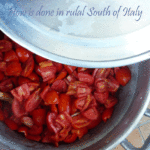
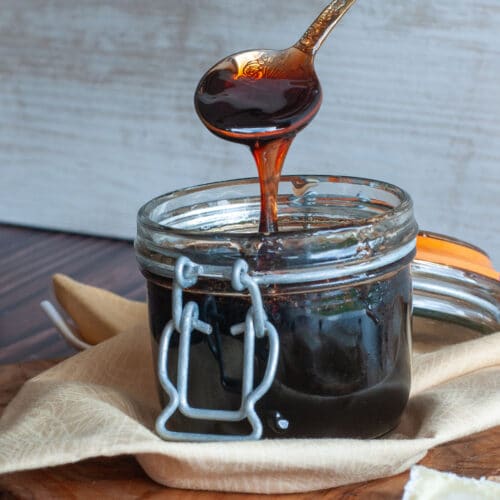
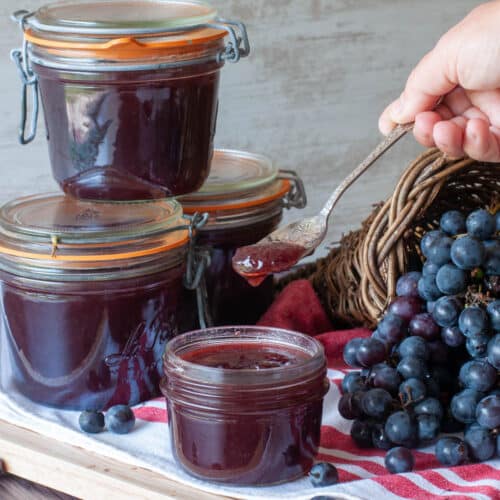
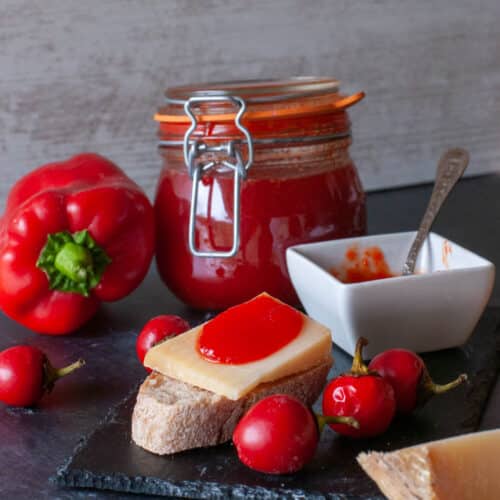
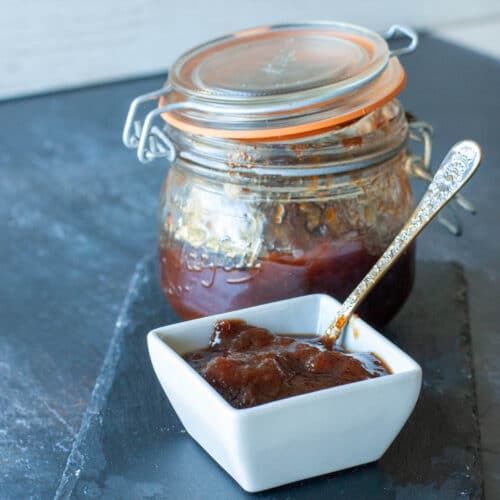


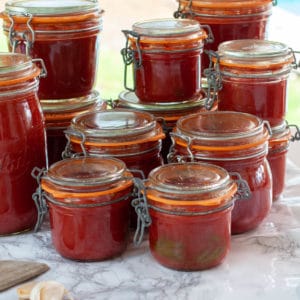

Beth
What a fun post, Laura! I currently have about a half a ton of tomatoes to deal with!! I love using the barrel and putting the burlap between! That's great!
Laura
That was so much fun, but it was last year. You still on time to come and join me, or may be I should since you have the tomatoes
Patty @pattysaveurs.com
Wow, I never tried canning my tomatoes but when I see those beautiful summer tomatoes, I really would like to try!
Michelle Frank | Flipped-Out Food
I had no idea that San Marzano tomatoes had been wiped out by disease! How awful. It makes me doubly glad that I don't shell out $6 US for a can of what is still LABELED San Marzano, but is clearly NOT. I love the idea of turning tomato sauce-making into an event. It has been a cool year here in Wisco, USA, but even so I have plenty of tomatoes to deal with. I've already made 2 big batches of sauce, so I'll have to pin this method for next year. The sauce looks and sounds absolutely delicious!
Laura
Thank you Michelle, I know it is unbelivable